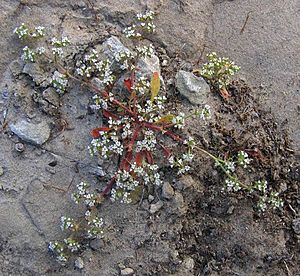Parry's spineflower facts for kids
Quick facts for kids Parry's spineflower |
|
|---|---|
 |
|
| Scientific classification | |
| Genus: |
Chorizanthe
|
| Species: |
parryi
|
The Chorizanthe parryi is a type of flowering plant. It belongs to the buckwheat family. People often call it Parry's spineflower or San Bernardino spineflower.
This plant grows only in Southern California. You can find it in places like the San Bernardino Mountains, San Gabriel Mountains, and parts of the Colorado Desert. It mostly lives in chaparral areas, which are dry lands with many shrubs.
What Does It Look Like?
Parry's spineflower is a small plant that spreads out along the ground. Its stems are a bit hairy. They can lie flat or stand up a little.
The plant has a few leaves, usually up to four centimeters long. These leaves grow mostly near the bottom of the stems.
The flowers are tiny and white. They have a special base that looks like an urn. This base is covered in woolly parts called bracts. The tips of these bracts can be straight or hooked. This small difference helps tell the two types of Parry's spineflower apart.
Different Kinds of Parry's Spineflower
There are two main types, or varieties, of Chorizanthe parryi:
- Chorizanthe parryi var. fernandina — This type is called the San Fernando Valley spineflower. It is also found only in Southern California. Long ago, it grew in about 10 places around the San Fernando Valley and nearby mountains. Sadly, many of these places were lost because of new buildings.
Botanists (plant scientists) thought this plant was gone forever after 1929. But in 1999, it was found again! Now, we only know of two places where it still grows. One is on Laskey Mesa in the Upper Las Virgenes Canyon Open Space Preserve in Ventura County. The other is near the Santa Clara River Valley in Los Angeles County.
Because it is so rare, the San Fernando Valley spineflower is listed as a critically endangered species. This means it is in great danger of disappearing completely. Both the California Department of Fish and Wildlife and the California Native Plant Society are working to protect it.
- Chorizanthe parryi var. parryi — This type is simply called Parry's spineflower or San Bernardino spineflower.

